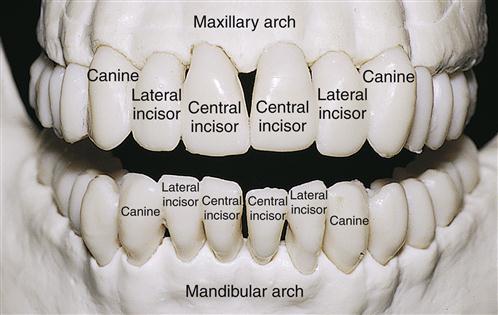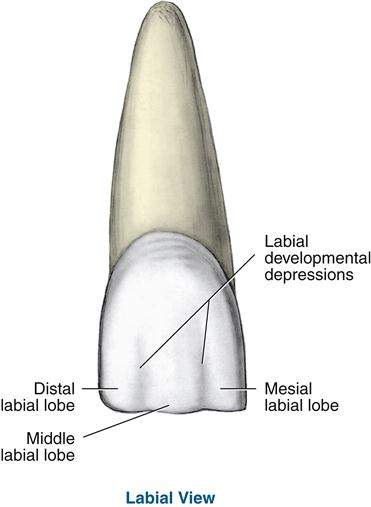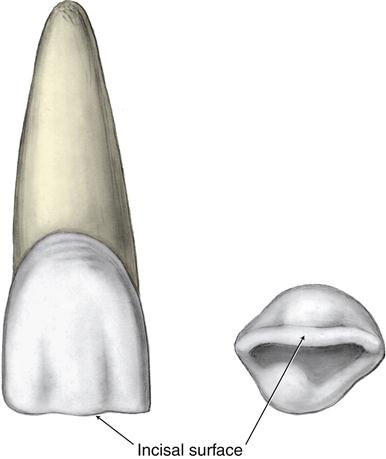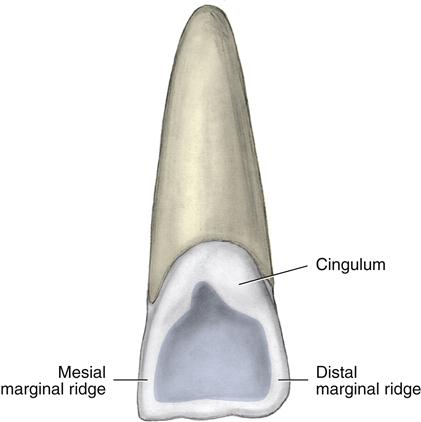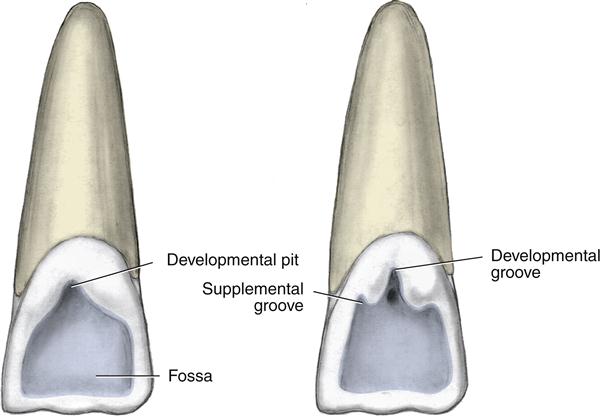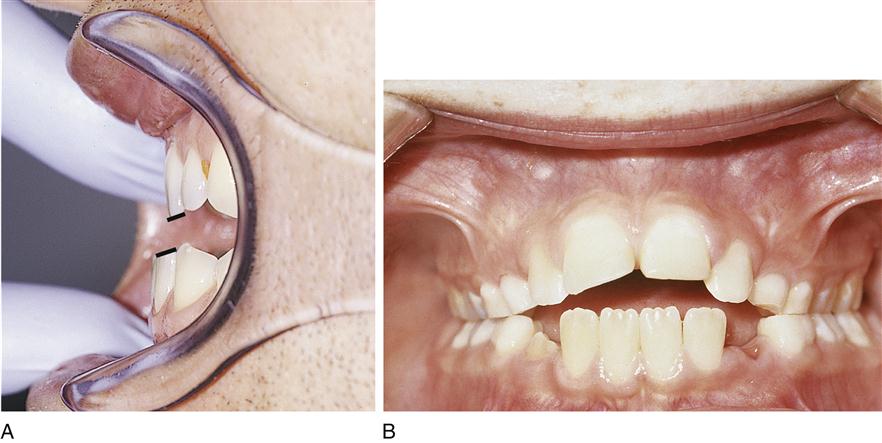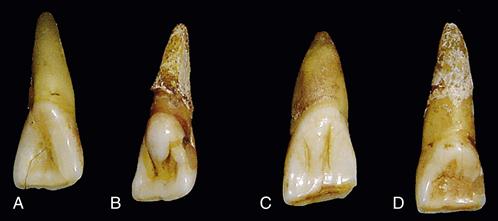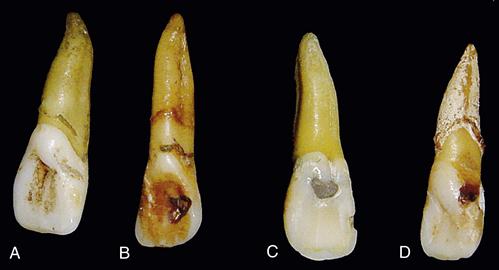Permanent Anterior Teeth
Learning Objectives
• Demonstrate the correct location of each permanent anterior tooth on a diagram and a patient.
• Use and pronounce the key terms when discussing the permanent anterior teeth.
New Key Terms
Avulsion (ah-vul-shin)
Cingulum (sin-gu-lum)
Cusp slope (kusp), tip
Cuspid (kus-pidz)
Developmental depressions, groove, pits (di-ah-ste-mah)
Diastema (di-ah-ste-mah)
Fossa (fos-ah) (plural, fossae, fos-ay)
Hutchinson’s incisors (hutch-in-suns in-sigh-zers)
Impacted (im-pak-ted)
Incisal angle (in-sign-sl), edge, ridge
Mamelons (mam-ah-lons)
Mesiodens (me-ze-oh-denz)
Peg lateral (lay-be-al), lingual, marginal
Ridge: labial (lay-be-al), lingual, marginal
Supplemental groove
Permanent Anterior Teeth
Permanent anterior teeth include the incisors and canines (Figure 16-1, see Figure 2-4, 15-1). All anterior teeth are composed of four developmental lobes: three labial lobes named mesiolabial, middle labial, and distolabial, and one lingual lobe (Figure 16-2). Two vertical labial developmental depressions outline the separations among the labial developmental lobes, the mesiolabial and distolabial developmental depressions. All permanent anterior teeth are succedaneous, which means that each one replaces the primary tooth of the same type. The development of the permanent dentition is discussed in Chapter 6.
The long crown of an anterior tooth has an incisal surface, which is its masticatory surface (Figure 16-3). From the labial and lingual, the crown outline is trapezoidal, or four-sided, with only two parallel sides. The longer of the two parallel sides is toward the incisal.
The crown outline is triangular when viewed from the proximal, with the base of the triangle at the cervical and the apex at the incisal edge (Figure 16-4). These teeth are wider mesiodistally than labiolingually when compared with posteriors. For anteriors, the height of contour, or crest of curvature, for both the crown’s labial and lingual surfaces is in the cervical third. Each contact area of anteriors is usually centered labiolingually on their proximal surfaces and has a smaller area than the contacts of posterior teeth (see Figure 15-10). On each proximal surface, the cementoenamel junction (CEJ) curvature of all anteriors is greater than that of the posteriors.
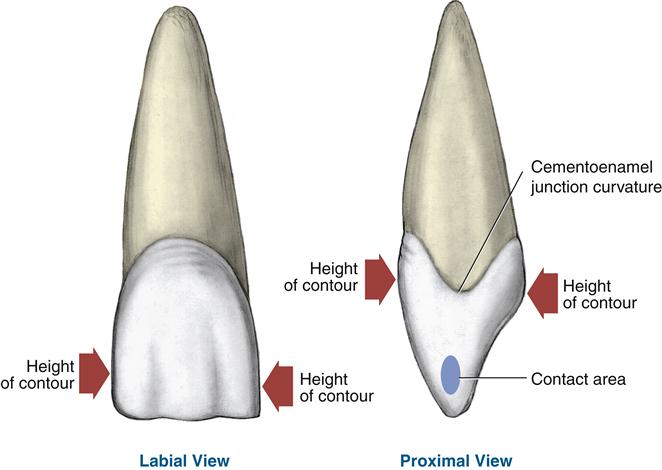
The lingual surfaces of all anteriors have a cingulum (Figure 16-5). The cingulum is a raised, rounded area on the cervical third of the lingual surface in varying degrees of prominence or development on anteriors. The cingulum corresponds to the lingual developmental lobe. Ridges may also be present on the lingual surface. The lingual surface on anteriors is bordered mesially and distally on each side by a rounded raised border, the marginal ridge.
Some anteriors have a more complex lingual surface with a fossa or even fossae, which are shallow, wide depressions (Figure 16-6). Some may also have developmental pits, which are located in the deepest part of each fossa. Other anteriors may have on their lingual surface a developmental groove, or primary groove, a sharp, deep, V-shaped linear depression that marks the junction among the developmental lobes.
In addition, a supplemental groove, or secondary groove, may also be present on the lingual surface of anteriors (Figure 16-6).
This is a shallower, more irregular linear depression. Supplemental grooves branch from the developmental grooves but are not always present in the same pattern on each different tooth type. In general, the more anterior the tooth is located in the arch, the fewer supplemental grooves are present and the smoother the lingual surface.
Anteriors usually have a single root, with some exceptions. Each root of the maxillary anterior teeth has great lingual and slight distal inclination (see Figure 20-9). Each root of the mandibular anterior teeth varies in angulation from nearly vertical to great lingual inclination, with the canines possibly having a slight distal root inclination.
Permanent Incisors
General Features
Permanent incisors are the eight most anterior teeth of the permanent dentition, with four in each dental arch (Table 16-1). The two types are the central incisors and the lateral incisors. The centrals are closest to the midline, and the laterals are the second teeth from the midline. One of each type is present in each quadrant of each dental arch. Both types are mesial to the permanent canines when the permanent dentition is fully erupted. The permanent incisors are succedaneous and replace the primary incisors of the same type. On occasion, the permanent incisors seem to spread out across the arch as a result of spacing during initial eruption and with the eruption of the permanent canines, these spaces often close. When newly erupted, each incisor also has three mamelons, or rounded enamel extensions on the incisal ridge from the labial or lingual views (Figures 16-7 and 16-8, B). The mamelons are extensions from the three labial developmental lobes.
TABLE 16-1
Anatomical Information on Permanent Incisors
| MAXILLARY CENTRAL INCISOR | MAXILLARY LATERAL INCISOR | MANDIBULAR CENTRAL INCISOR | MANDIBULAR LATERAL INCISOR | |
| Universal number | #8 and #9 | # 7 and #10 | # 24 and #25 | #23 and #26 |
| General crown features | Incisal edge and incisal angles | |||
| Specific crown features | Widest crown MD, greatest CEJ curve, and height of contour; distal offset cingulum, shallow lingual fossa, marginal ridges | Greatest crown variation, like a smaller maxillary central, prominent lingual surface; centered cingulum, pronounced marginal ridges | Smallest and simplest tooth, bilaterally symmetrical; small centered cingulum, subtle lingual fossa, and equal subtle marginal ridges | Like a larger mandibular central, not bilaterally symmetrical; appears twisted distally; small, distally placed cingulum; lingual fossa and moderate mesial marginal ridge longer than distal |
| Height of contour | Cervical third | |||
| Mesial contact | Incisal third | |||
| Distal contact | Junction of incisal and middle thirds | Middle third or junction with incisal third | Incisal third | Incisal third |
| Distinguishing right from left | Sharper MI angle, rounder DI angle, more pronounced mesial CEJ curvature | |||
| General root features | Single-rooted | |||
| Specific root features | Overall conical shape; no proximal root concavities | Bow shaped on cross section; root is longer than the crown; proximal root concavities give double-rooted appearance | ||
| Rounded apex; triangular in cross section | Root curves distally, with sharp apex; oval in cross section; same or longer than central but thinner | |||
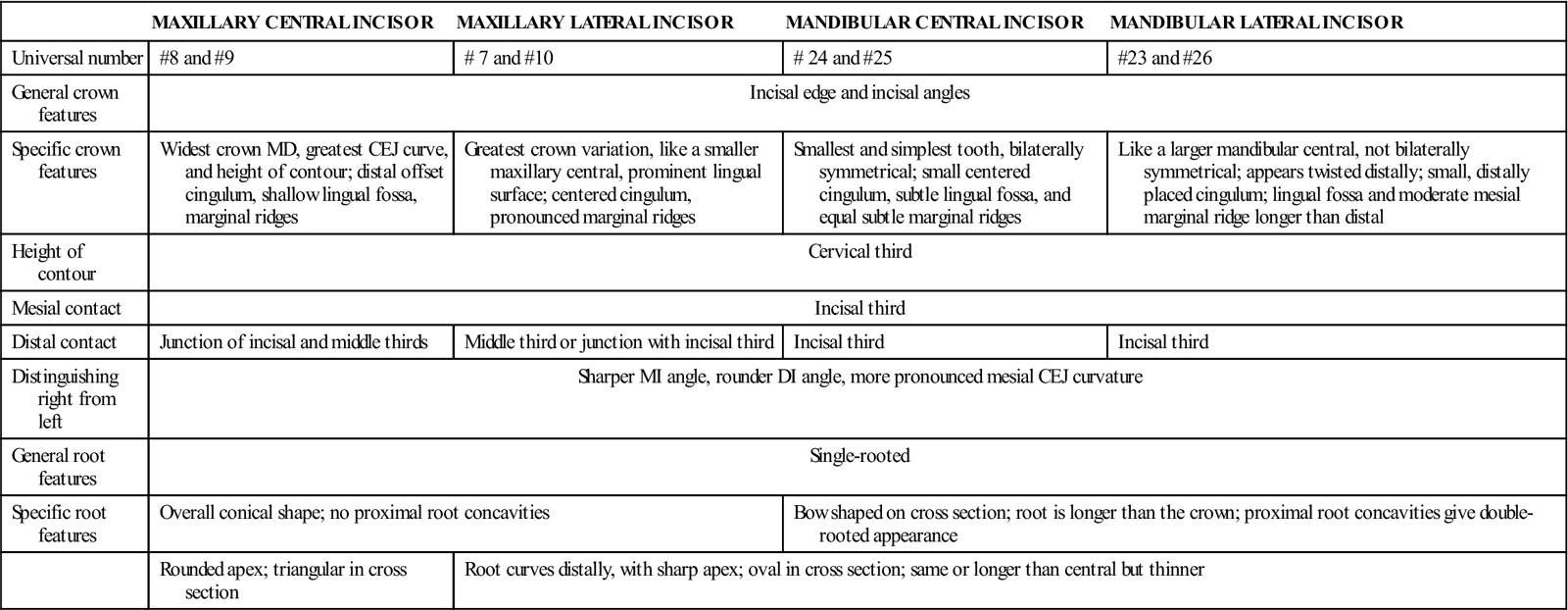
CEJ, Cementoenamel junction; DI, distoincisal; MD, mesiodistally; MI, mesioincisal.
The incisors are also the only permanent teeth with two incisal angles formed from the incisal ridge or incisal edge (discussed later) and each proximal surface. Incisors of both types are the only permanent teeth with a nearly straight incisal ridge, which is a linear elevation on the masticatory or incisal surface when newly erupted—thus the name incisors.
The lingual surface has a cingulum that corresponds to the lingual developmental lobe, although its prominence or development differs for each type of incisor. These teeth also have a lingual fossa and marginal ridges on the lingual surface, again in differing developmental levels for each type of incisor. The height of contour for both labial and lingual surfaces of all incisors is at the cervical third, as is the case for all anteriors.
Permanent Maxillary Incisors
General Features
Permanent maxillary incisors are the four most anteriorly placed teeth of the maxillary arch. Each has a crown that is larger in all dimensions, especially mesiodistally, compared with a mandibular incisor. In addition, the labial surfaces are rounder from the incisal aspect, with the tooth tapering toward the lingual.
All lingual surface features, including the marginal ridges, lingual fossa, and cingulum, are more prominent on the maxillary incisors than on the mandibular incisors. Finally, the incisal edge is just labial to the long axis of the root from either proximal view.
Each root is short compared with those of other maxillary teeth and usually is without root concavities. Bulbous and pronounced crowns may also create deep mesial and distal concavities at the CEJ.
The central and lateral incisors of the maxillary arch resemble each other more than they resemble the similar type of incisors of the opposing arch. Generally, a maxillary central incisor is larger than a maxillary lateral incisor, but overall they have a similar form. Both types of maxillary incisors are wider mesiodistally than labiolingually.
Permanent Maxillary Central Incisors #8 and #9
Specific Overall Features (Figure 16-11)
Permanent maxillary central incisors erupt between 7 to 8 years of age (root completion at age 10). Thus, these teeth usually erupt after the mandibular central incisors. Many child patients want these two teeth to come in fast to fill their wide arch space when they shed their four primary maxillary incisors, as in the old song, All I Want for Christmas Is My Two Front Teeth.
Stay updated, free dental videos. Join our Telegram channel

VIDEdental - Online dental courses


